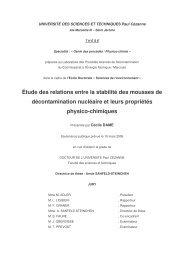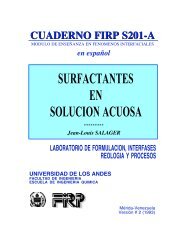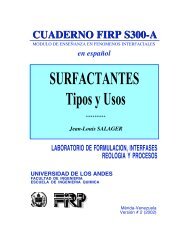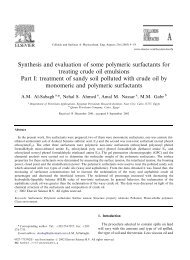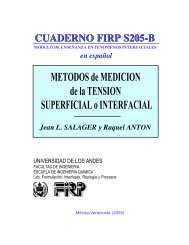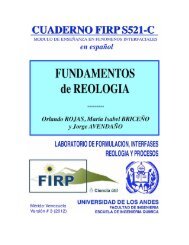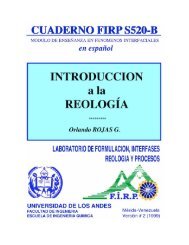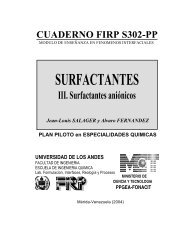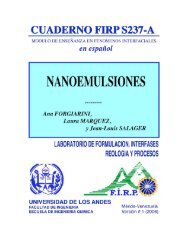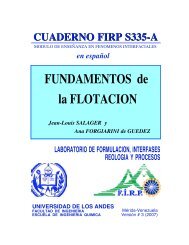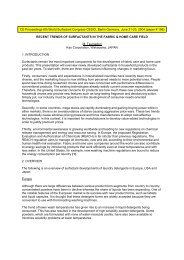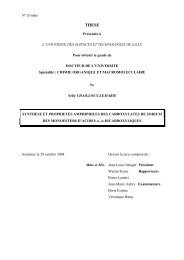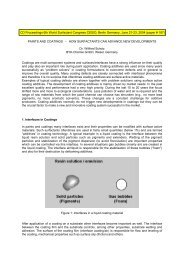Solubilization-emulsification mechanisms of detergency
Solubilization-emulsification mechanisms of detergency
Solubilization-emulsification mechanisms of detergency
You also want an ePaper? Increase the reach of your titles
YUMPU automatically turns print PDFs into web optimized ePapers that Google loves.
C.A. Miller and K.H. Raney/Colloids Surfaces A: Physicochem. Eng. Aspects 74 (1993) 169-215 197<br />
observed during the experiment. When the drop<br />
composition reaches point F at the end <strong>of</strong> the<br />
coexistence curve, the driving force for<br />
diffusion <strong>of</strong> the surfactant and water into the<br />
drop remains. gut because the drop cannot<br />
remain in the L2 region, according to the phase<br />
diagram, the lamellar phase begins to form.<br />
A theory has been developed which predicts<br />
that the time t from the start <strong>of</strong> the experiment<br />
until the liquid crystal starts to form is given by<br />
the following expression [60]<br />
2<br />
t = Ks (R0 /Dsws∞) (6)<br />
Here R 0 is the initial radius <strong>of</strong> the drop, D s and<br />
are the diffusivity and bulk concentration <strong>of</strong> the<br />
surfactant in the aqueous solution and K s is a<br />
constant that depends only on the shape <strong>of</strong> the<br />
coexistence curve and the location <strong>of</strong> point F.<br />
The predicted proportionality between t and Ro<br />
2 has been confirmed by experiment (see Fig.<br />
34), as has the inverse relationship between t and<br />
the bulk surfactant concentration w s∞. With a<br />
Fig. 34. Plot <strong>of</strong> the square root <strong>of</strong> the time t required<br />
to initiate liquid crystal formation as a function <strong>of</strong><br />
initial drop size for the system <strong>of</strong> Fig. 32. The<br />
surfactant concentration in the aqueous phase is 1.0<br />
wt.% [74]. Reprinted with permission <strong>of</strong> Plenum<br />
Press.<br />
value <strong>of</strong> 0.514 for K. calculated using the phase<br />
behavior <strong>of</strong> Fig. 32, Eq. (6) and the measured<br />
values <strong>of</strong> t were used to estimate Ds. A value <strong>of</strong><br />
about 4 x 10 -11 m 2 s -1 was obtained, which is<br />
reasonable for a micellar solution.<br />
A similar equation has been developed for the<br />
case <strong>of</strong> a uniform layer <strong>of</strong> oil on a flat solid<br />
surface immersed in a stirred aqueous surfactant<br />
solution [74]<br />
t = K p (h 0d/D sw s∞) (7)<br />
where ho is the initial thickness <strong>of</strong> the oil layer<br />
and d is the thickness <strong>of</strong> the diffusion boundary<br />
layer adjacent to the oil. Like Ks in Eq. (6), Kp depends only on the shape and terminal point <strong>of</strong><br />
the coexistence curve between the L1 and L2 phases.<br />
For the C12E8-water-n-decanol system at<br />
temperatures above 14ºC, the three-phase<br />
triangle bounding the L1-L2 region has D'<br />
instead <strong>of</strong> Lα as the additional phase [59]. When<br />
a contacting experiment was conducted at 27ºC<br />
in this system, with a drop initially about 60 µm<br />
in diameter, a liquid intermediate phase<br />
developed after about 14 min and surrounded<br />
the initial alcohol drop [55]. As the intermediate<br />
phase grew during the next 8 min to a diameter<br />
<strong>of</strong> about 83 mm, the alcohol drop shrank slightly<br />
to a diameter <strong>of</strong> about 83 µm. Presumably, this<br />
growth process could be analyzed using a<br />
"shrinking core" model with the quasi-steady<br />
state approximation. However, as the available<br />
data on phase behavior [59] do not include<br />
coexistence curves for the L1-D' and L2-D' two-phase regions, it is not currently possible to<br />
make quantitative comparisons between<br />
predictions <strong>of</strong> the analysis and the experimental<br />
results.<br />
7.3. Experiments with mixtures <strong>of</strong> hydrocarbons<br />
and long-chain alcohols<br />
More interesting for <strong>detergency</strong> applications<br />
than pure alcohols are mixtures <strong>of</strong> polar and<br />
nonpolar oils, which are representative <strong>of</strong><br />
sebum-like soils. Here we discuss a series <strong>of</strong><br />
experiments in which drops <strong>of</strong> various mixtures<br />
<strong>of</strong> n-hexadecane and oleyl alcohol, typically



